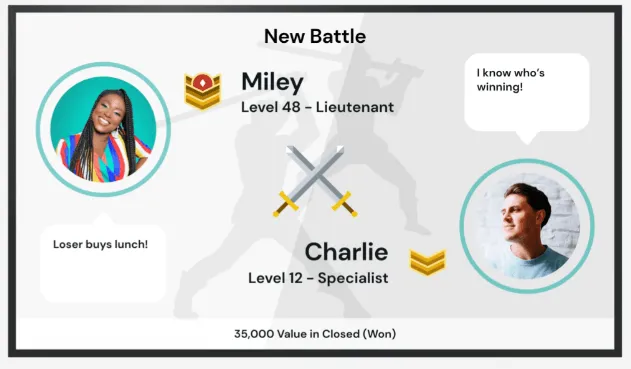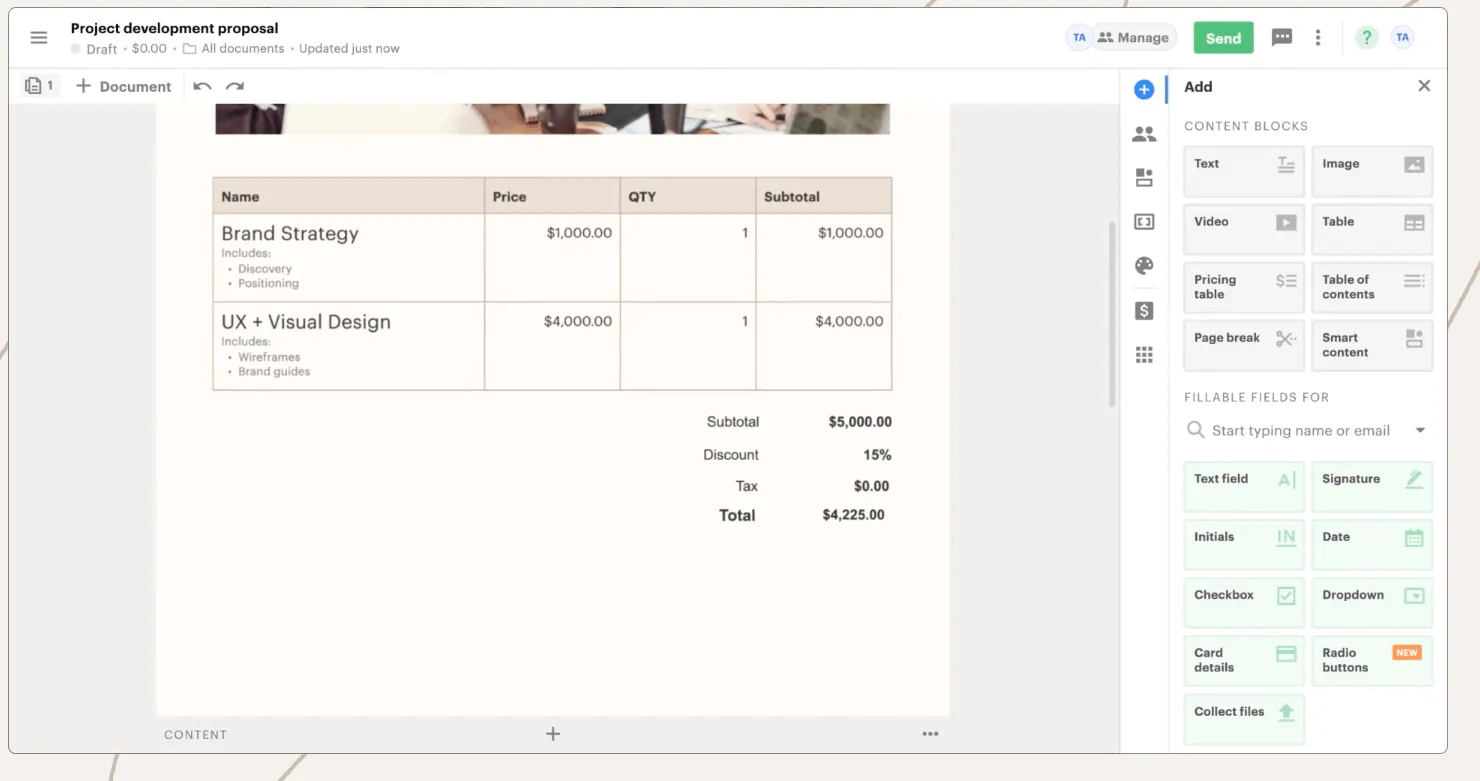
The success of your sales team is vital to company success, but a potential US recession (a consensus estimate puts the risk of recession at 65 percent) adds an additional note of urgency.
A sales organization that makes its staff adopt a lone-wolf mindset will struggle, while sales teams with mutually beneficial, collaborative cultures will be positioned to snap up customers and contracts should the market tighten.
In the B2B world, where deals are often complex with long buyer journeys and multiple stakeholders, a sales team must be a “team”. It must be a collaborative environment that allows each member to build on each other’s work and learn from and support each other to achieve the team’s goals.
This guide provides actionable tips to foster teamwork and collaboration in your sales team.
4 Benefits of Collaboration and Teamwork in Sales
Is fostering a collaborative sales culture really that important? It is, and not just because it creates a more positive work environment. Other benefits include:
1. Increased Sales
While not the only upside, we would be remiss to start with anything else! Collaboration helps sales teams close more deals and grow the revenue pipeline.
Collaboration makes the sales process more effective. Most B2B companies have moved away from a sales model where one salesperson is responsible for the entire sales pipeline. B2B sales is a multi-stage process that loops in salespeople with more tightly defined skills.
Many teams employ junior salespeople in SDR roles to focus on outreach and booking meetings, and more experienced salespeople as business development managers (BDMs) or Account Executives (AEs).
Success with this model requires SDRs and AEs to work together effectively, passing qualified customers from SDR to AE smoothly. For this model to work successfully, you need close collaboration between SDRs and AEs. Data sharing and real-time communications tool, such as Slack, are indispensable.
2. Improved Customer Satisfaction
Customers can tell if they’re working with a harmonious sales team. Good communication, data sharing (such as call recordings), and clear SDR-AE alignment ensures streamlined handoffs between SDRs and AEs.
Prospective clients won’t have to field repeated questions and can be confident their pain points have been properly understood and absorbed into the sales team’s CRM. A well-practiced formal handover between SDRs and AEs demonstrates a high level of professionalism.
A salesperson should have direct access to the information that their customers request. Deploying a well-managed CRM and aligning your team on the importance of swift and accurate responses ensures a good customer experience.
Curious about the impact of B2B CRMs on your sales funnel? Our article provides an in-depth analysis and actionable tips.
3. Increased Employee Engagement
Sales is a tough job that requires a high degree of psychological resilience; all salespeople face rejection, day in and day out. A sales leader who can create a collaborative and supportive work environment will boost their employees’ motivation and commitment to the cause. A collaborative team can generate positive and healthy competition and a sense of accountability.
The sales leader’s responsibility is to encourage a culture of open communication, recognition of good teamwork, and professional development and growth opportunities. Such a culture can be the difference between a junior SDR faltering in the face of setbacks and pushing through and growing as a salesperson.
Ready to make waves? Our article provides expert insights into sales manager training strategies.
4. Reduced Turnover
Happy and productive workers are less likely to leave a company. Most people realize that happy work environments are valuable and desirable and will think twice before jumping ship. Combine that with a clear, fair, and achievable upward career path within the company and loyalty will follow.
It seems generally accepted that the competitive and individualistic sales world has a higher churn rate than other departments (we couldn’t verify a much-cited 35 percent churn rate, however). Sales leaders must work hard to retain high-performing workers and a collaborative culture is the best way to do that.
6 Steps to Improve and Foster Sales Team Collaboration
Fostering a collaborative sales culture requires careful planning. Team structure, sales process, meeting cadences, incentives, responsibilities and more all feed into a team’s collaborative culture.
Follow these six steps to nurture a collaborative sales culture and take sales team performance to the next level.
1. Set Clear Goals and Expectations
It’s up to the sales manager to align all team members on their team’s monthly, quarterly, and annual sales goals.
Where relevant, align on secondary goals such as:
- Reducing churn rate.
- Shortening the sales cycle.
- Qualifying sales leads
- Reducing customer acquisition costs.
- Growing customer lifetime value.
These goals should be SMART: Specific, Measurable, Accurate, Realistic, and Time-bound.
 |
Some companies might choose to set stretch goals (borderline unachievable goals with high incentives), but we don’t recommend them as they can have the opposite of the intended effect.
For monthly, quarterly, and annual targets, it’s not enough to pluck some numbers out of the air. Target setting is serious work and synthesizes several data points, such as average deal value, close rates, and annual revenue targets.
These are necessary to set realistic goals, which are vital to staff well-being and motivation. If the goals are too difficult, the worker will likely give up; too easy and they’ll start to coast.
Sales staff should understand how their individual goals flow into team goals and how team goals power the company’s long-term strategic vision.
2. Create a Culture of Trust and Respect
Environment is best thought of as combining two components: culture and climate. Both require different approaches to create a cultural change.
According to Owen Richards, founder and CEO of Air Marketing, the UK’s leading outsourced sales/demand gen agency, culture is:
“[...] the things you do - socials, perks, training, incentives. A good culture is one that constantly invests in its people and makes the workplace the best it can be.”
One technique that can greatly impact culture is providing extra training opportunities. Although perhaps not the most tantalizing prospect at first glance, more often than not the commission-based nature of sales means reps want to improve their skills and get better in their roles. This can be a great motivator in both the short and long term.
Meanwhile, Owen says:
[Climate is] “how it feels to work here. How does it feel to work in that team or walk into that room? Are people engaged and happy? Are they feeling positive? Do they like coming in every day?”
At Cognism, we’ve found that working on team climate saw increases in sales performance.
We implemented the following:
- Demonstrating positive reinforcement.
- Celebrating individuals and their contributions.
- Holding honest 1-1s.
- Holding good team meetings where everyone has the chance to speak.
Salespeople need to feel comfortable sharing ideas and working together without fear of judgment or criticism.
3. Encourage Communication and Collaboration
With a culture of trust and respect in place, communication and collaboration can flourish. A good sales leader should ensure their team has the opportunity to share ideas, learn from each other, and work together on deals. Additionally, consider exploring how to choose softphone for large business that enables seamless and effective communication among team members.
The relationship between SDRs and AEs is particularly important here and it relies on regular, honest communication. The SDR-AE relationship must allow for open conversations, the ability to ask questions, provide constructive feedback, offer advice, and to be there to listen when issues arise.
The close relationship between the two parties means they need to be willing to work hard for each other. Sales reps need to communicate, asking about what they don’t know, flagging bad accounts, and asking for and learning from feedback.
Meanwhile, an AE should support the development of SDRs, maintaining an open-door policy, and reviewing accounts promptly.
4. Celebrate Successes and Learn from Failures
When the team achieves a goal, be sure to celebrate its success. Similarly, when the team makes a mistake, take the opportunity to learn from it and improve.
It’s not about good vibes for good vibes’ sake, although that is worth something in itself. In our experience, improved morale leads to an increase in closed deals. This can be particularly true among remote workers, whose numbers have grown in the post-pandemic landscape. Even though it has its upsides, the isolation of remote work can be draining. Extra efforts to foster team camaraderie are always worthwhile.
Here are a few ideas that Cognism has found success with:
- Creating Slack channels for posting the best calls/deals of the week.
- Using services such as SalesScreen to gamify outreach and foster healthy team competition.
- Hosting internal award ceremonies to recognize successes.
- Holding group meetings to review unsuccessful calls and learn from them. Remember, though, that not every unsuccessful call is a failure!
 |
5. Provide the Right Tools and Resources
It’s common practice for a salesperson to have a tried and tested tech stack to assist with sales admin tasks.
Salespeople have many tools to choose from, spanning prospecting, outreach, communication, collaboration, and sales process management and automation (Explore the latest trends and advancements in AI technology within the realm of B2B sales and expand your knowledge.)
Sales leaders also have options to assist in team management. When designing a tech stack, pay attention to integrations, as they can have a big impact on productivity.
These are some tools that Cognism’s team has found success with:
Cognism
Cognism’s sales team uses our proprietary sales prospecting tool, Prospector. Prospector helps sales teams find ideal targets and contacts and provides verified direct dials. It offers unrestricted individual and page-level viewing and exporting.
Slack
A versatile communications tool, Slack provides sales teams with a platform for sharing and learning from calls. The ability to connect with third-party organizations also makes it a great account management communication tool.
Gong
Gong captures and analyzes every touchpoint in the sales process to deliver real-time insights on meetings, calls, and emails. Cognism uses Gong to take snippets from high-performers calls and share them with ramping SDRs, resulting in shorter ramp periods.
Seismic
Seismic helps sales teams manage the content they use to close deals, train new SDRs, and set up sales cycles with personalized content.
Zoom
The best-known video conferencing software can be indispensable for B2B sales teams. Five subscription models make it appropriate for companies of all sizes.
PandaDoc
Proposal, contract, and document solution PandaDoc simplifies the contract creation and signing workflow. PandaDoc makes it easy for clients to sign and ensures consistency in clauses repeated across multiple contracts, such as terms and conditions.
 |
Outreach
Outreach is a unified sales engagement, revenue intelligence, and revenue operations platform. It helps market-facing teams efficiently create and predictably close more pipeline.
Close
As a sales-focused CRM, Close makes it easier for sales teams to stay on top of new leads, track contact information, and even build workflows for sales automation. For sales teams looking to get more done, you can't beat Close!
6. Recognize and Reward Individual and Team Accomplishments
It can be a tricky balancing act to incentivize salespeople as individuals and as a team. Motivation is highly unique; what might motivate one person could fail to do so to the next.
Our advice is to tie incentives to roles and base them on your company’s top-level objectives. For example:
If a company wants to expand rapidly, incentives will be around winning clients. If a company wants to lift its profit margins, deal value will likely be more important. For an SDR, those two goals could mean incentives based on attended meetings or closed deal value.
To understand what motivates your team members and how best to incentivise their performance, start by discovering their sales personality. Ask yourself: what do your individual team members care about and respond to?
Cognism has found success in basing incentives on highly personalized desires. If the rep values time with their family, then giving them hours back at the end of the week or a work-from-home day are huge motivators.
Sales Collaboration: The Final Word
All the most important areas of sales - revenue, customer satisfaction, and employee satisfaction and retention - benefit from a collaborative culture.
At Cognism, a focus on creating a collaborative sales environment contributed to a doubling of revenue in 2022.
Cognism used techniques such as giving micro-promotions (e.g. the addition of “senior” to an SDR’s job title, for example) and requiring additional duties such as mentoring (increased responsibility boosts self-esteem).
Teamwork is essential for success in sales. A collaborative team will close more deals, increase customer satisfaction, and be happier and more loyal to the company.










